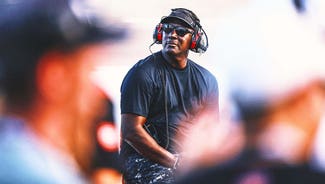
Restart rules and spoiler add excitement to Pocono
This weekend marks the anniversary of NASCAR’s double-file restarts.
It’s not that cars hadn’t lined up alongside each other for restarts in the past, but starting with the 2009 Pocono 500, the sanctioning body adopted the process in which the lead lap cars restarted according to position, with the driver at the point electing which lane to start.
Initially, reviews were mixed about the change. For drivers who excel at restarts, it was game on. For drivers who are slow out of the gate, the move was not as favorable.
Certainly, most competitors have warmed to the idea in the last year. And from the fan standpoint, the move has been a resounding success.
“It’s gone well,” said Robin Pemberton, NASCAR's Vice President of Competition. “I think it’s made the races better most everywhere if not everywhere, but some race tracks in particularly. Here, with the long straightaways at Pocono, was a big change, (as well as at) road courses, where the traffic can get strung out real quick on a restart.
“All in all, I think the garage has adapted real well to it.”
Despite Denny Hamlin’s Pocono prowess — three wins, average finish of 9.5 — he doesn’t feel that restarts are his forte. Hamlin praises teammate Kyle Busch’s ability to maneuver on green, but offers himself a grade of “C” on restarts because generally he loses more positions than he gains through the process.
Still, Hamlin believes double-file restarts have had a dramatic effect on racing, particularly at Pocono, where cars traditionally spread out quickly once the race went green. Hamlin feels the spoiler, which makes its Pocono debut this weekend, will intensify the action.
“We’re used to single-file spread-out racing at this track, and next thing you know we were four-wide in Turn 3 at this track,” Hamlin said. “With the spoiler you’re going to see even more of that. The draft is so big with the spoilers on these cars down the straightaway, if you run side by side, you lose a ton of time to the guy in front or behind you — (but) mostly to the guy behind you because he’s going to just suck up and draft right by you.
“It seems like it’s much worse with the spoiler than it is with the wing. So the guy in second almost has a bigger advantage now than he did in years past. You could almost sit and not necessarily slingshot a guy, but you can sit back there and conserve your car.”
Kurt Busch, who will roll off fourth Sunday, expects drivers will witness “an extreme draft” triggered by double-file restarts that will challenge the engines. Busch agrees with Hamlin that drivers will have to conserve their equipment to be there at the end.
“When we have double-file restarts and we’re all packed together for the first 10 laps of a run, there’s going to be some big runs that you’re going to be seeing down the front straightaway,” Busch said. “The draft will increase the RPMs and we’ll probably be up against the rev chip, so some guys will be close to over-revving; we’ll have to make sure that we take care of that. You don’t want to abuse the car by staying on the rev chip too long, but you don’t want to give up precious speed out on the race track.”
From a strategy standpoint, Dale Earnhardt Jr. feels the outside line has been preferable on most race tracks. Earnhardt, who qualified third on Friday and was eighth fastest (164.381 mph) in final practice, admits that if a driver draws the wrong line, precious track position can be lost in a hurry.
“That's kind of unfortunate when you have a lot of late restarts and you keep getting stuck in the inside line every damn time because you just keep losing a couple spots, and then there's another wreck and then you're on the inside again,” Earnhardt said. “You can really lose a lot of track position that way (by) just being unfortunate.
“It really makes it exciting and a lot of fun if you have a good car — it's a quick way to make up some spots. It's real challenging to pass in the second half or the last two-thirds of a tire run. It's so much harder to pass cars, so you can make up a lot of positions there if you're quick and clever on them restarts."
Trading places
During a two-day tire test at Watkins Glen this week, Jeff Gordon learned more about his car — and the competition — than he had anticipated.
Gordon, who has won four times at the Glen, ran laps along with Marcos Ambrose and Jeff Burton. But after switching cars with Ambrose, he quickly understood why the Tasmanian driver receives so much buzz on road courses.
“I learned two things there at the test,” Gordon said. “One is that when Marcos Ambrose goes really fast through the road courses, it’s not his race car. He’s just really fast. He got in my car and went really fast. I got in his car and went slow. It was just basically that Marcos is fast and that we’ve got really good power.”
Numbers game
There were seven Chevrolets among the top 10 on the speed chart in Happy Hour final practice. Jeff Burton led the pack with lap of 166.085 mph. Hamlin was third fastest in a Joe Gibbs Racing-powered Toyota, while Martin Truex Jr. posted the ninth-fastest lap (164.363mph) in a TRD (Toyota Racing Development) Toyota. The lone Ford among the top 10 was Kasey Kahne (164.492 mph) representing Richard Petty Motorsports. Kahne will be the only Ford starting among the top 10 for Sunday’s Gillette Fusion ProGlide 500 at Pocono.

